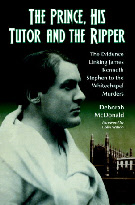[The author and publisher have kindly shared with readers of the Victorian Web this discussion of homosocial and homosexual activity from the second chapter of The Prince, His Tutor and the Ripper by Deborah McDonald. Published by McFarland Press. 2010. ISBN 978-0-7864-3018-5.]
The body was lying naked in the middle of the bed.... The left arm was close to the body with the forearm flexed at a right angle and lying across the abdomen, the right arm was slightly abducted from the body and rested on the mattress.... The legs were wide apart, the left thigh at right angles to the trunk and the right forming an obtuse angle with the pubes. The whole of the surface of the abdomen and thighs was removed and the abdominal cavity emptied of its viscera. The breasts were cut oŻ, the arms mutilated by several jagged wounds and the face hacked beyond recognition of the features. . . . The viscera were found in various parts viz; the uterus and kidneys with one breast under the head, the other breast by the right foot, the liver between the feet, the intestines by the right side and the spleen by the left side of the body. . . . The face was gashed in all directions the nose, cheeks, eyebrows and ears being partly removed ... the Heart absent.
This extract was taken from the gruesome post mortem report written by Dr. Bond on examination of the body of Mary Kelly. She is most commonly thought of as the final victim of the serial killer who has become known as “Jack the Ripper.“ He perpetrated at least five terrible murders in the East End of London in the fall of 1888. To date no one has solved the mystery of his identity, although many have tried.

James Kenneth Stephen is one of the suspects. In almost every volume on Jack the Ripper, Stephen’s name appears. This book will look closely at his life in order to examine the evidence so far proposed and add much new detail. Several “Ripperologists“ have been convinced that Stephen alone was the Ripper. Some writers have concocted complicated plots in which they say he was involved and others have implicated him because of his family connections or mental health. Yet, surprisingly, none of them have carried out any serious research into his life. This has led to many inaccuracies being written. These authors have based their suppositions on what little was known about Stephen’s personality rather than actual events in his life. Their information comes secondhand via his cousin, Virginia Woolf, writing after his death, or from a couple of poems which, they say, proved that he hated women and which he wrote long after the Ripper had put away his knives. He was a misogynist with a mental health problem, they surmise, therefore he must be Jack the Ripper. No further investigation has been done into this fascinating and tortured life either to prove or disprove their theories.
J.K. Stephen became tutor to Prince Albert Victor, the heir apparent. The two men remained in touch long after their close association at Sandringham and Cambridge, through correspondence and through their mutual acquaintances. The prince, either singly or in association with James Stephen, has also been accused of being the Ripper. The investigation into the life of Stephen, therefore, necessitates delving into what little remains of accounts of the prince’s life, although much material formerly held on him in the Royal Archives has been destroyed. Montague John Druitt is another Ripper suspect whose life appears inextricably linked with both Stephen and Prince Albert Victor. Therefore, although the book will be centered on James Kenneth Stephen’s fascinating and tragic life, a full investigation cannot be completed without including more than a mention of the Prince and Druitt. All three men died in tragic and controversial circumstances in their late twenties or early thirties and within three years of each other. Montague John Druitt’s death was particularly mysterious — murder cannot be ruled out. Several new items of primary evidence have been uncovered. The most important is the diary of Lady Mary Stephen, J.K. Stephen’s mother. In this she describes the terrible course and progression of her son’s illness. She details the effect on him of an unfulfilled love affair, the trauma of which left him mentally unbalanced by the fall of 1888. It is a strange diary that appears to have been written retrospectively — probably based upon her appointments diary — but it provides, for the first time, documented facts about Stephen’s life.
Many letters written by J.K. Stephen to his friends and relatives have been found, which give us clues as to his personality and movements. The newly discovered report he wrote summing up his work as tutor to the prince, plus the correspondence written during his stay at Sandringham, provide greater insight into both the relationship between the Prince and Stephen as well as details of their time together. Of the prince little archival material remains, beyond a couple of contemporary biographies and a few letters. Why did the palace destroy his records? What were they trying to hide? Despite this attempt by the family to destroy his records, one important new source of evidence has been discovered elsewhere: the lengthy paper written by William Broadbent, the physician in charge at the prince’s deathbed. Broadbent comments on those in attendance. There is an unexpected and disturbing description of the response to his illness by Eddy’s fiancée, Princess May, who, shortly after his death, married his brother, George, thereby ensuring she would still become queen of England.
This book will add to the store of facts which may one day lead to a more informed guess as to who was the murderer and mutilator of so many deprived women in the East End of London in 1888. Maybe his identity has been revealed in the following pages. Please judge for yourself.
Related Material
Last modified 14 April 2010